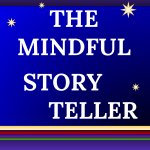
“The old stone circles that predate the Celtic era by centuries were the first meeting places, erected to put people into correct alignment and spiritual communion with past, present, and future, and with all the beings no longer living as well as those yet to be born.” – Caitlin Matthews, The Celtic Spirit, p. 119.
∞∞∞∞∞∞∞∞
What happens as we “create the story space”? Like those prehistoric stone circles, the created story space may serve as a place where the past and the future can live together in the present moment.
When our family gathers and we begin to share stories of loved ones who have died, we are engaged in “spiritual communion with past, present, and future.” While my family would roll their eyes as such lofty language and ideals, I’d argue that, through our storytelling, we are inviting the departed back into our circle. We are inviting them to come alive for us.
There is this commonplace marvel of a break in the space/time continuum through storytelling: Let’s take, as an example, stories shared in my family about our Uncle Dudley. My brother, sister-in-law, Mom, adult niece, and I laugh at the antics of Uncle Dudley as we remember him and his ways, while, in the same moment and at the same table, my children, my niece’s children, and the other younger members of our family are also laughing because they, too, “know” Uncle Dudley. They, however, have no actual memories of him – they know him only through the stories. They appreciate his goofy antics. They see his smile, but their experience is not “memory” as it is for the elders; their experience is imagining – and, over the years, as more Uncle Dudley stories are told and retold, their imaginings are re-imagined and “memory” is built through their imaginations – memory of story told and told again.
We are all in the realm of uncertain images. My memories are not identical to my brother’s – though we have a great deal of overlap and we can both “picture” Uncle Dudley. For the younger generation the “picturing” is different, some of them may have seen photos of Uncle Dudley, many of them have not – they are deciding in their mind’s eye what he looked like, imagining the sound of his voice or his gestures.
Uncle Dudley died in 1978, but is he present with us? Is he smiling as we smile? Is he laughing with those who were not yet born when he left us? Nearly every traditional culture throughout the history of humanity would answer these questions in the affirmative, with a simple and unpretentious “yes.”
∞∞∞∞∞∞∞∞
Storytelling is communion, for many it is “spiritual communion.” Film, books, letters, and artifacts allow us to “touch the past.” The well-told tale also enables the past to breathe again. When we share a story with someone who is younger we can give them some taste, some touch, some smell of what was. Sometimes a story of pain or sorrow from the past is a gift that will strengthen, educate, or embolden the next generation; sometimes a story of lightness or joy will water beneficial seeds. Think of one story from the past that you want to tell. What person of the past will you bring to life for your listeners?
(Music: Courtesy of Adrian Von Ziegler, “Sacred Earth.” )